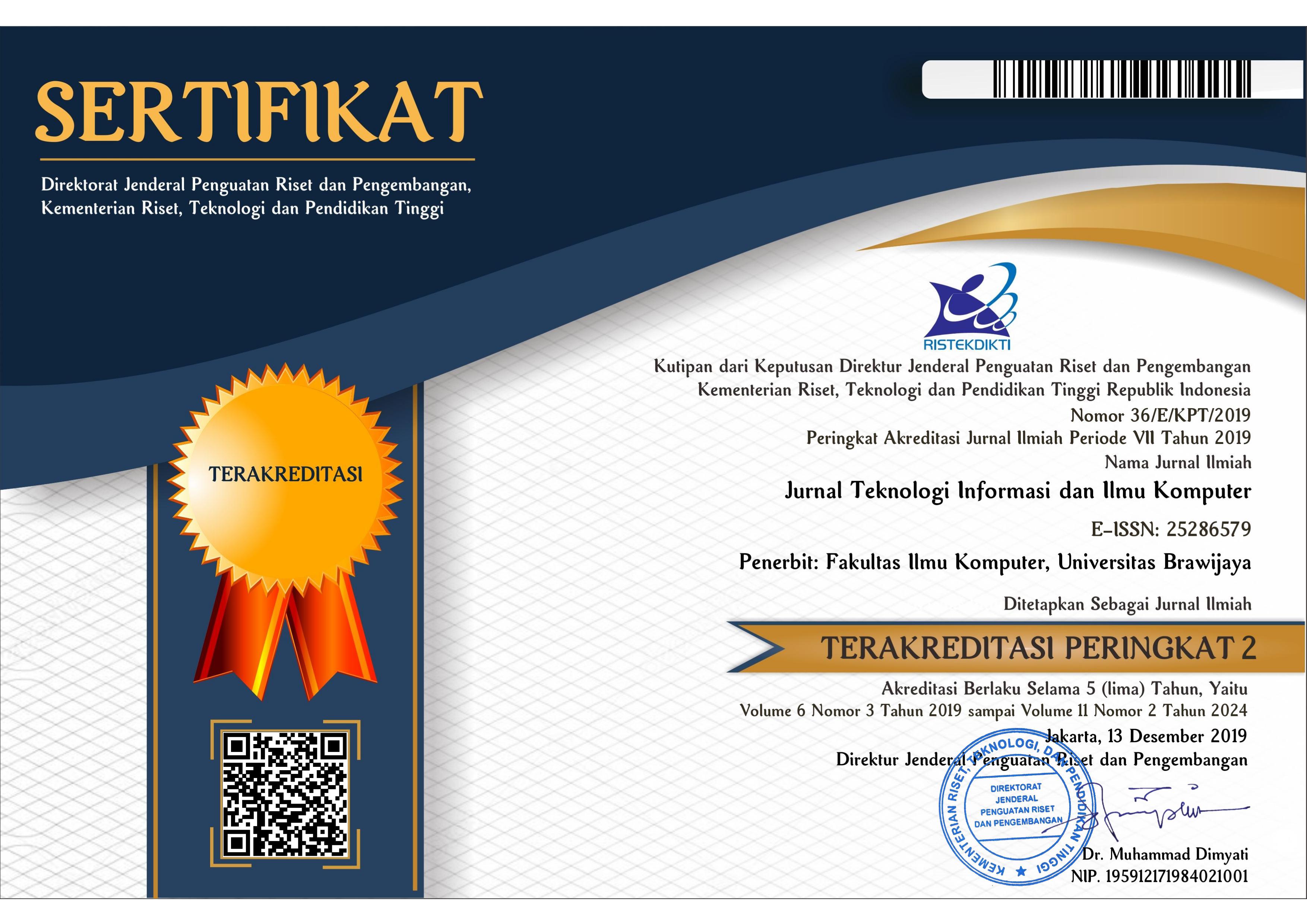Peningkatan Network Lifetime Pada Wireless Sensor Network Menggunakan Clustered Shortest Geopath Routing (C-SGP) Protocol
DOI:
https://doi.org/10.25126/jtiik.201743336Abstrak
Abstrak
Jaringan sensor nirkabel atau wireless sensor network adalah sebuah jaringan yang terdiri dari banyak sensor node, yang berfungsi untuk memindai fenomena tertentu di sekitarnya. Masing-masing sensor node pada umumnya memiliki sumber daya energi berupa baterai, yang memiliki kapasitas terbatas, sehingga diperlukan sebuah teknik untuk meningkatkan network lifetime pada wireless sensor network. Pada penelitian ini, protokol routing Shortest Geopath (SGP) dikembangkan menjadi sebuah protokol routing berbasis cluster, dengan membagi jaringan menjadi beberapa cluster yang masing-masing memiliki cluster head. Pembentukan cluster dilakukan dengan menggunakan informasi geografis area jaringan untuk membentuk cluster berupa segi enam (hexagon). Penentuan cluster head dilakukan dengan mencari node yang memiliki posisi geografis paling dekat dengan titik tengah area cluster. Pengiriman data dilakukan dengan sistem adaptif, dimana data dengan prioritas rendah dikirim setelah mencapai jumlah data tertentu, dan dikirim setelah melalui proses rata-rata sehingga hanya menghasilkan satu data untuk dikirim. Data dengan prioritas tinggi, dikirim langsung menuju sink. Hasil simulasi menunjukkan peningkatan network lifetime hingga 25,68% jika dibandingkan dengan protokol routing Shortest Geopath yang tidak melalui proses clustering.
Kata kunci: Network Lifetime, clustering, Shortest Geopath Routing, Wireless Sensor Network
Abstract
Wireless sensor network is a type of network consisting many sensor nodes. Each sensor node has a limited battery capcity, which most of the time, cannot be recharged. Thus, researches on extending network lifetime of wireless sensor networks are indispensable. This research proposed a cluster-based routing protocol, which adds clustering phase to the Shortest Geopath Routing (SGP) protocol. Cluster formation is done by forming imaginary hexagons using geographical informations about the network. Node which is nearest to the center point of the hexagon is appointed to be cluster head. Data transmissions are controlled by an adaptive mechanism. Low priority datas are only sent after the responsible node already obtained a specified number of datas. The datas, then, are being averaged and wrapped into a single data to be sent to the sink. Very high priority datas are, however, directly sent to the sink without passing the averaging process. It reduces the number of transmissions, which eventually help extending the network lifetime together with the clustering mechanism. Simulation results showed that the proposed protocol increases network lifetime up to 25.68% compared to the original un-clustered Shortest Geopath Routing protocol.
Keywords: Network Lifetime, clustering, Shortest Geopath Routing, Wireless Sensor Network
Downloads
Referensi
DIETRICH, I., & DRESSLER, F. 2009. On the Lifetime of Wireless Sensor Network. ACM Transactions on Sensor Networks, Vol. 5, No. 1, 1-38.
GHICA, O., TRAJCEVSKI, G., SCHEUERMANN, P., BISCHOF, Z., & VALTCHANOV, N. 2007. Demo Abstract: SIDnet-SWANS: A Simulator and Integrated Development Platform for Sensor Networks Application. Evanston, IL, USA: Departement of EECS, Northwestern University.
HEINZELMAN, W., CHANDRAKASAN, A., & BALAKRISHNAN, H. 2005. Energy-Efficient Communication Protocols for Wireless Microsensor Networks. Proceedings of the 33rd Hawaaian International Conference on Systems Science (HICSS).
JANNU, S., & JANA, P. K. 2014. Energy Efficient Grid Based Clustering and Routing Algorithm for Wireless Sensor Network. Fourth International Conference on Communication Systems and Network Technologies. Dhanbad, India.
KAUR, M., & AMARVIR, S. 2016. Detection and Mitigation of Sinkhole Attack in Wireless Sensor Network. International Conference onMicro-Electronics and Telecommunication Engineering (ICMETE). Ghaziabad, India.
LEE, J. S., & KAO, T. Y. 2016. An Improved Three-Layer Low-Energy Adaptive Clustering Hierarchy for Wireless Sensor Networks. IEEE Internet of Things Journal, 951-958.
MAGHSOUDLOU, A., ST-HILAIRE, M., & KUNZ, T. 2011. A Survey on Geographic Routing Protocols for Mobile Ad Hoc Networks. Technical Report SCE-11-03, Carleton Unversity.
RAJAGOPALAN, R., & VARSHNEY, P. K. 2006. Data Aggregatin Techniques in Wireless Sensor Network: A Survey. IEEE Communications Surveys and Tutorials, 48-63.
Unduhan
Diterbitkan
Terbitan
Bagian
Lisensi

Artikel ini berlisensi Creative Common Attribution-ShareAlike 4.0 International (CC BY-SA 4.0)
Penulis yang menerbitkan di jurnal ini menyetujui ketentuan berikut:
- Penulis menyimpan hak cipta dan memberikan jurnal hak penerbitan pertama naskah secara simultan dengan lisensi di bawah Creative Common Attribution-ShareAlike 4.0 International (CC BY-SA 4.0) yang mengizinkan orang lain untuk berbagi pekerjaan dengan sebuah pernyataan kepenulisan pekerjaan dan penerbitan awal di jurnal ini.
- Penulis bisa memasukkan ke dalam penyusunan kontraktual tambahan terpisah untuk distribusi non ekslusif versi kaya terbitan jurnal (contoh: mempostingnya ke repositori institusional atau menerbitkannya dalam sebuah buku), dengan pengakuan penerbitan awalnya di jurnal ini.
- Penulis diizinkan dan didorong untuk mem-posting karya mereka online (contoh: di repositori institusional atau di website mereka) sebelum dan selama proses penyerahan, karena dapat mengarahkan ke pertukaran produktif, seperti halnya sitiran yang lebih awal dan lebih hebat dari karya yang diterbitkan. (Lihat Efek Akses Terbuka).








